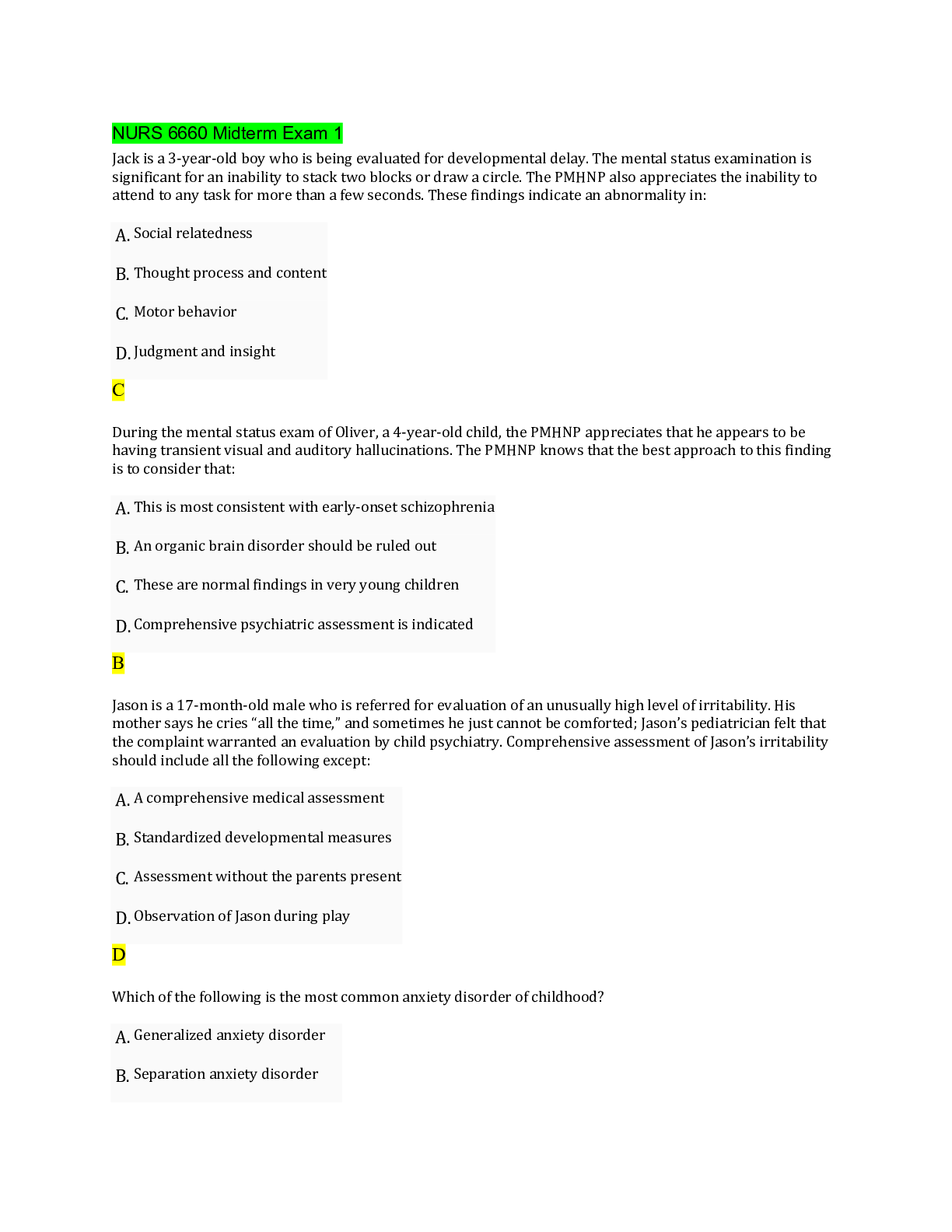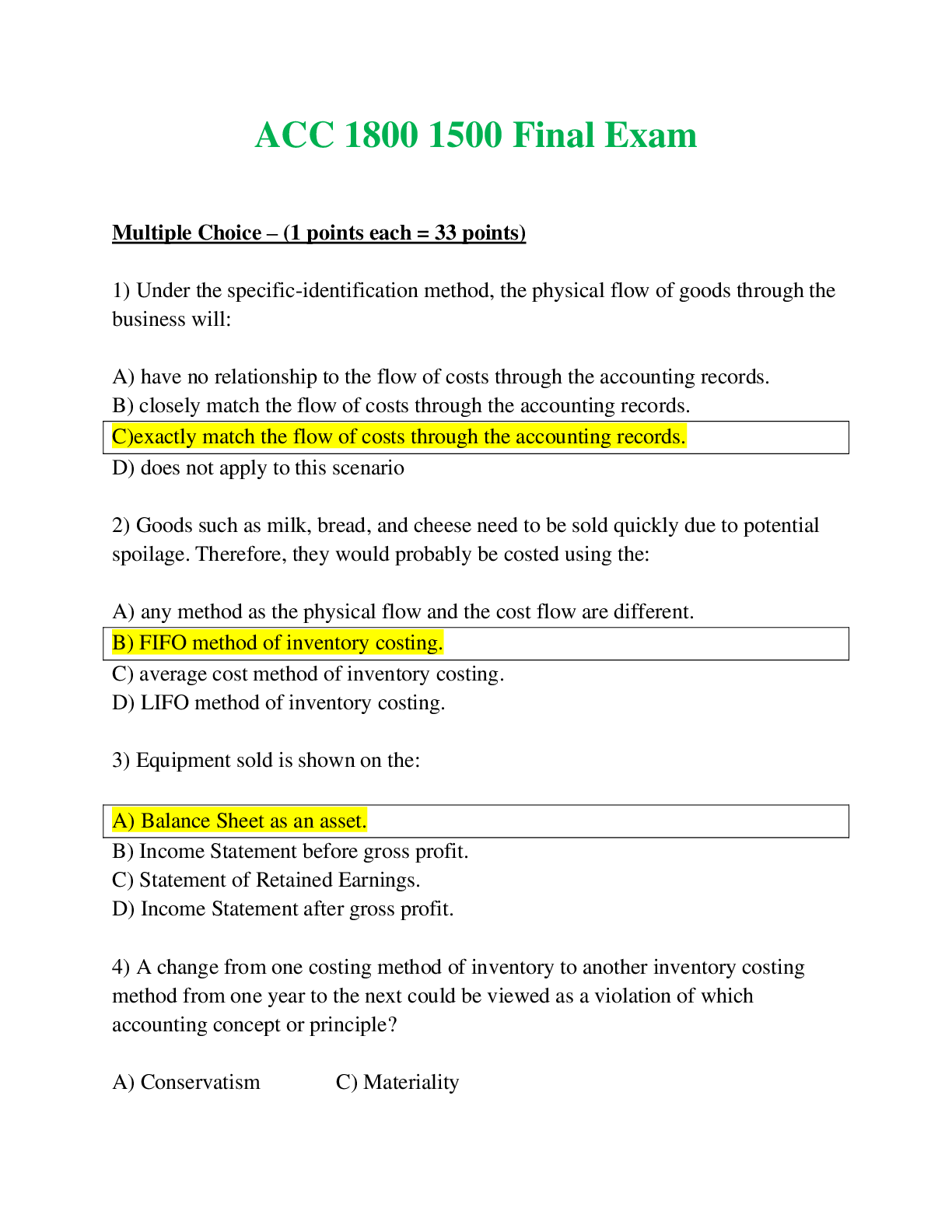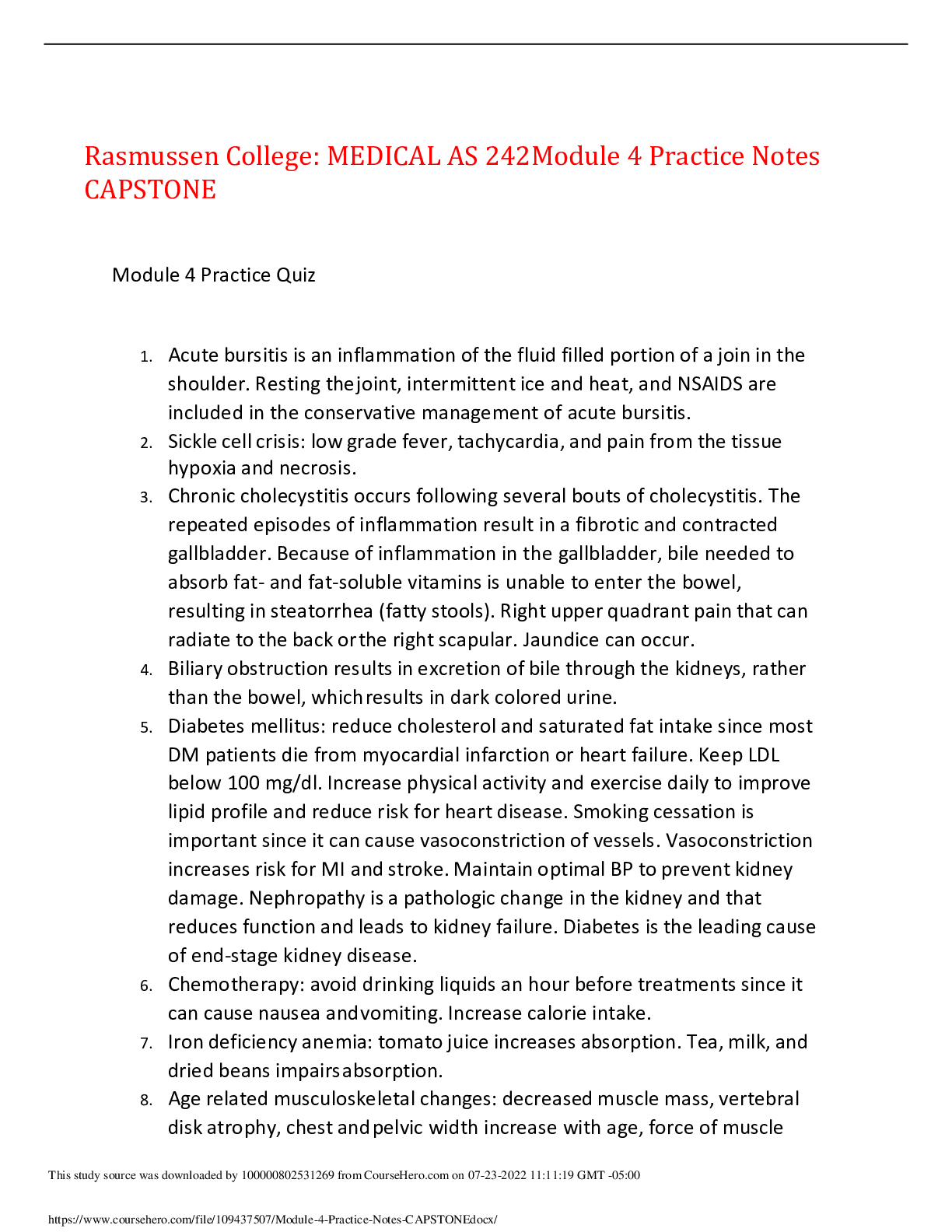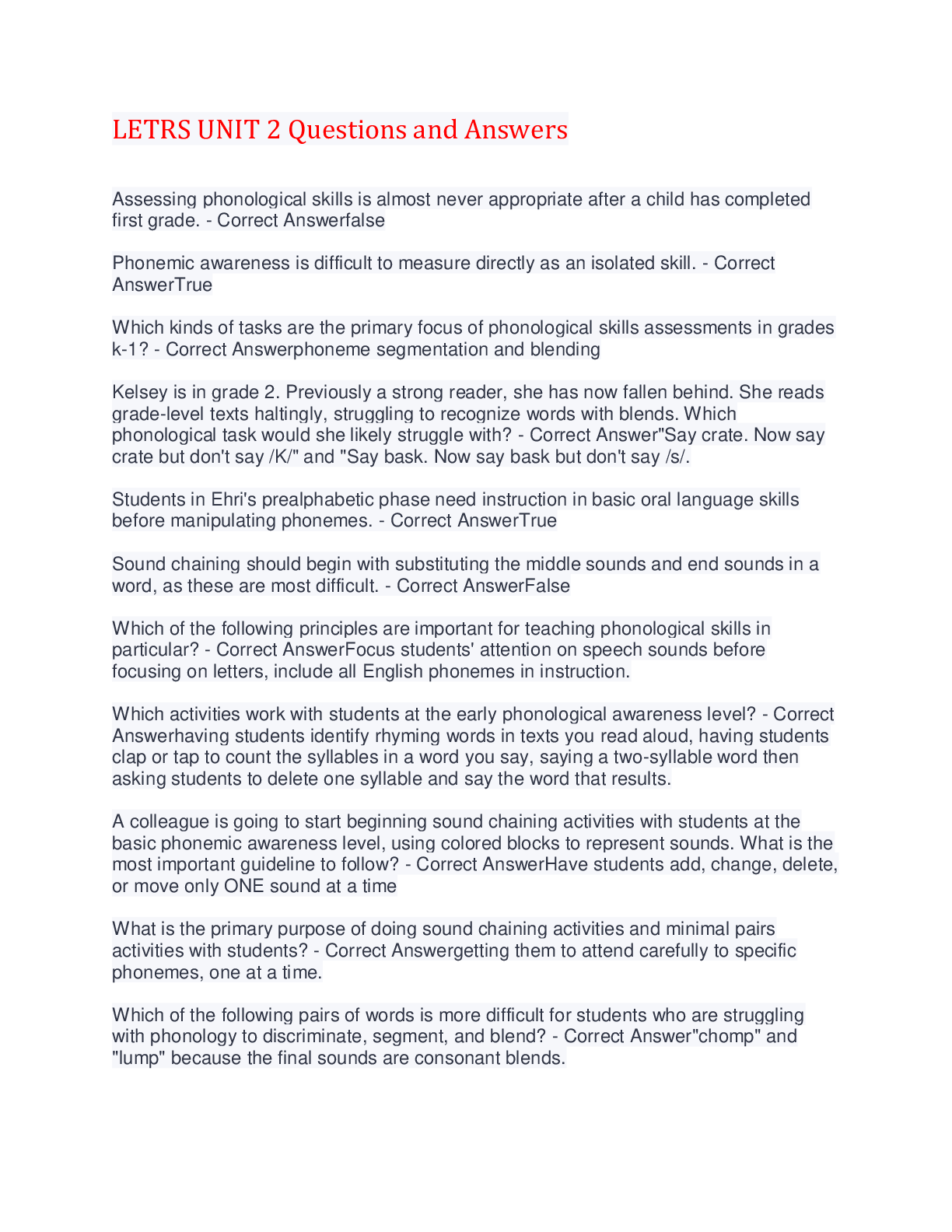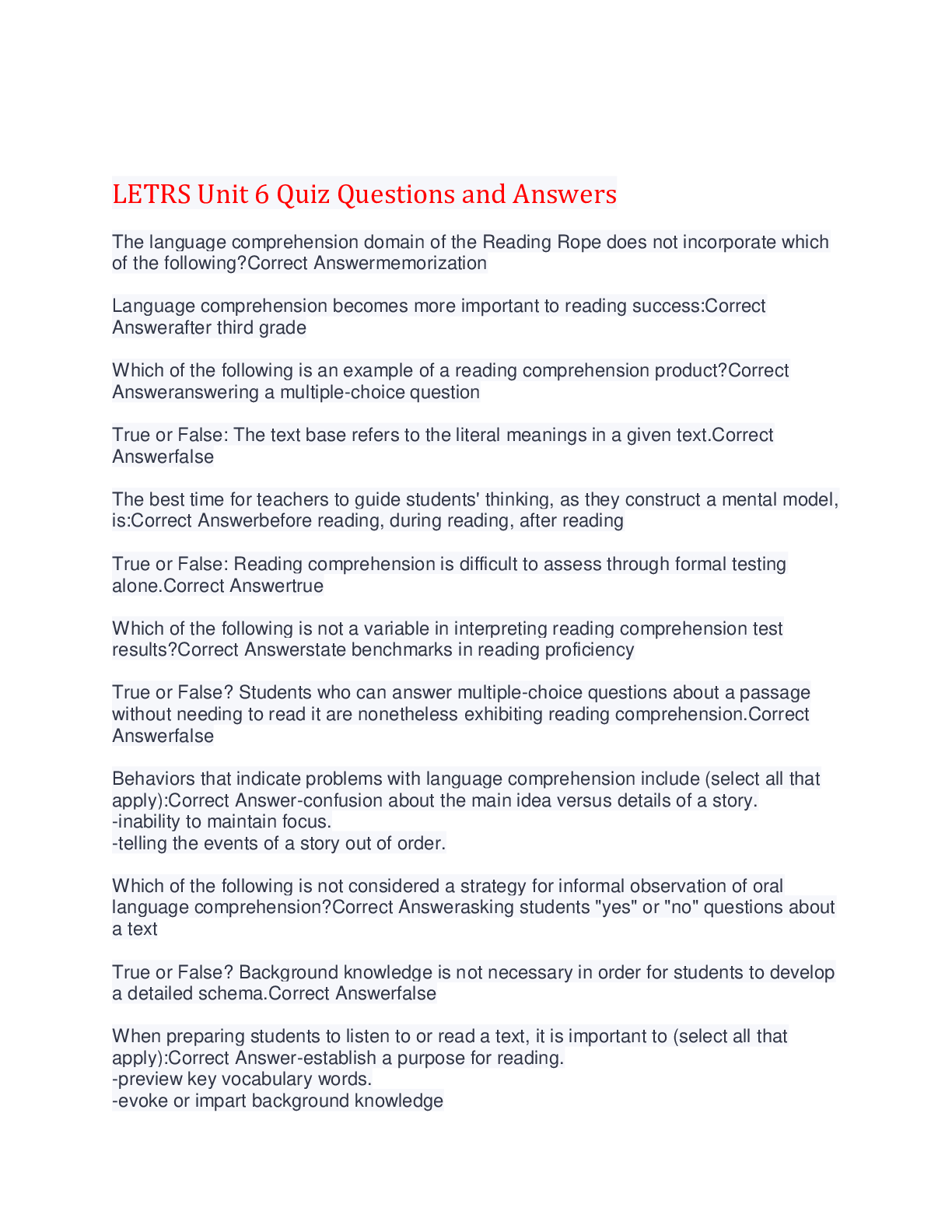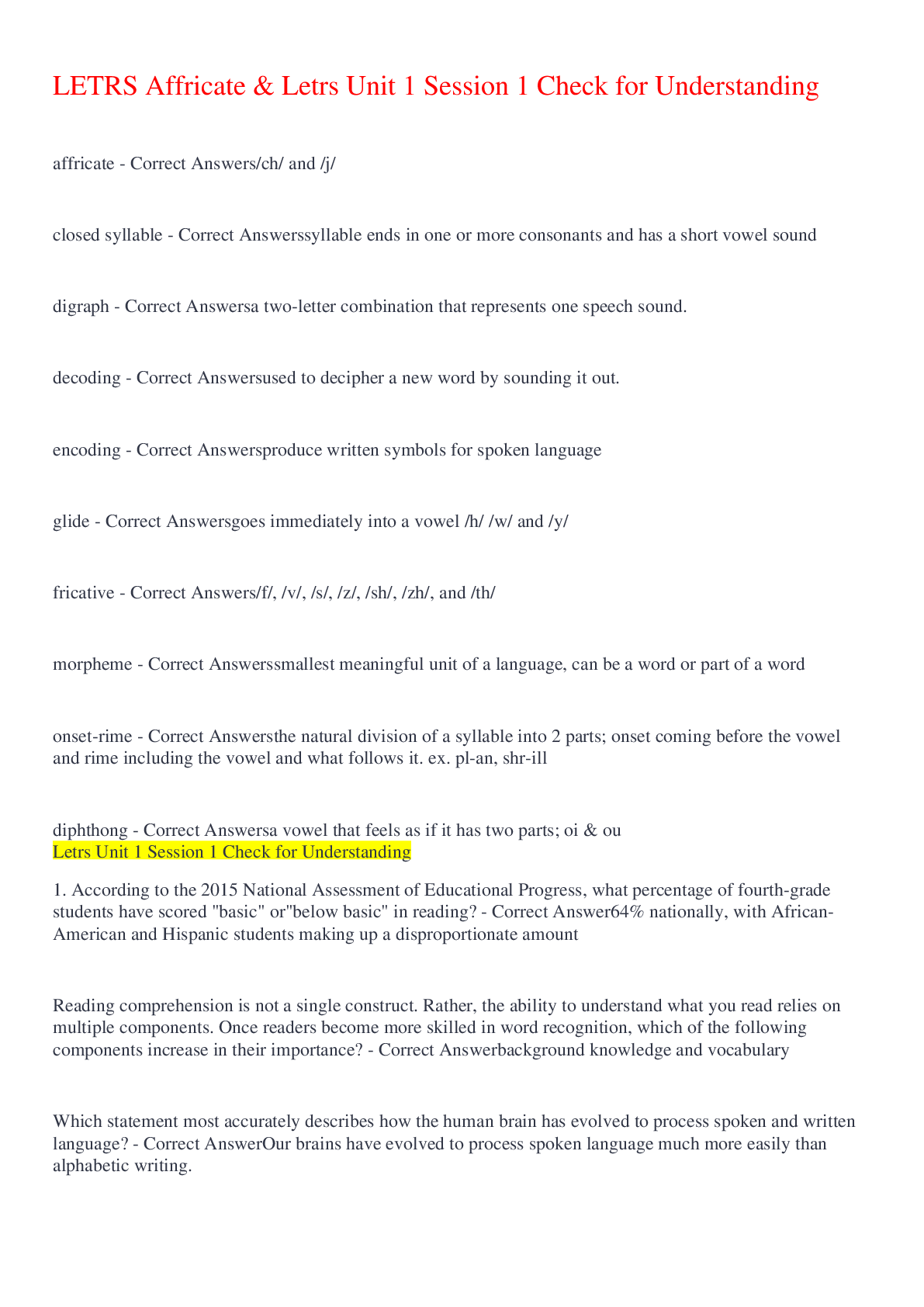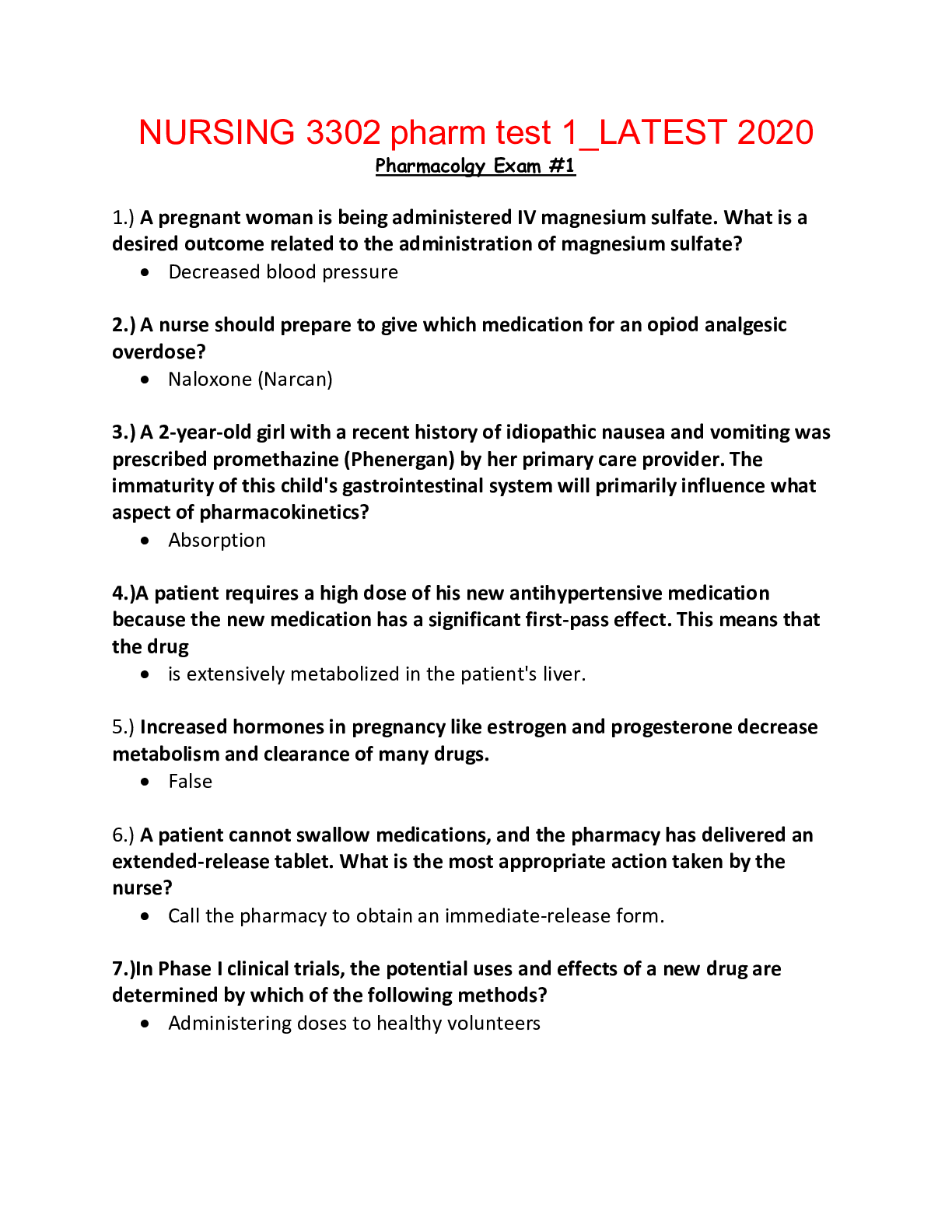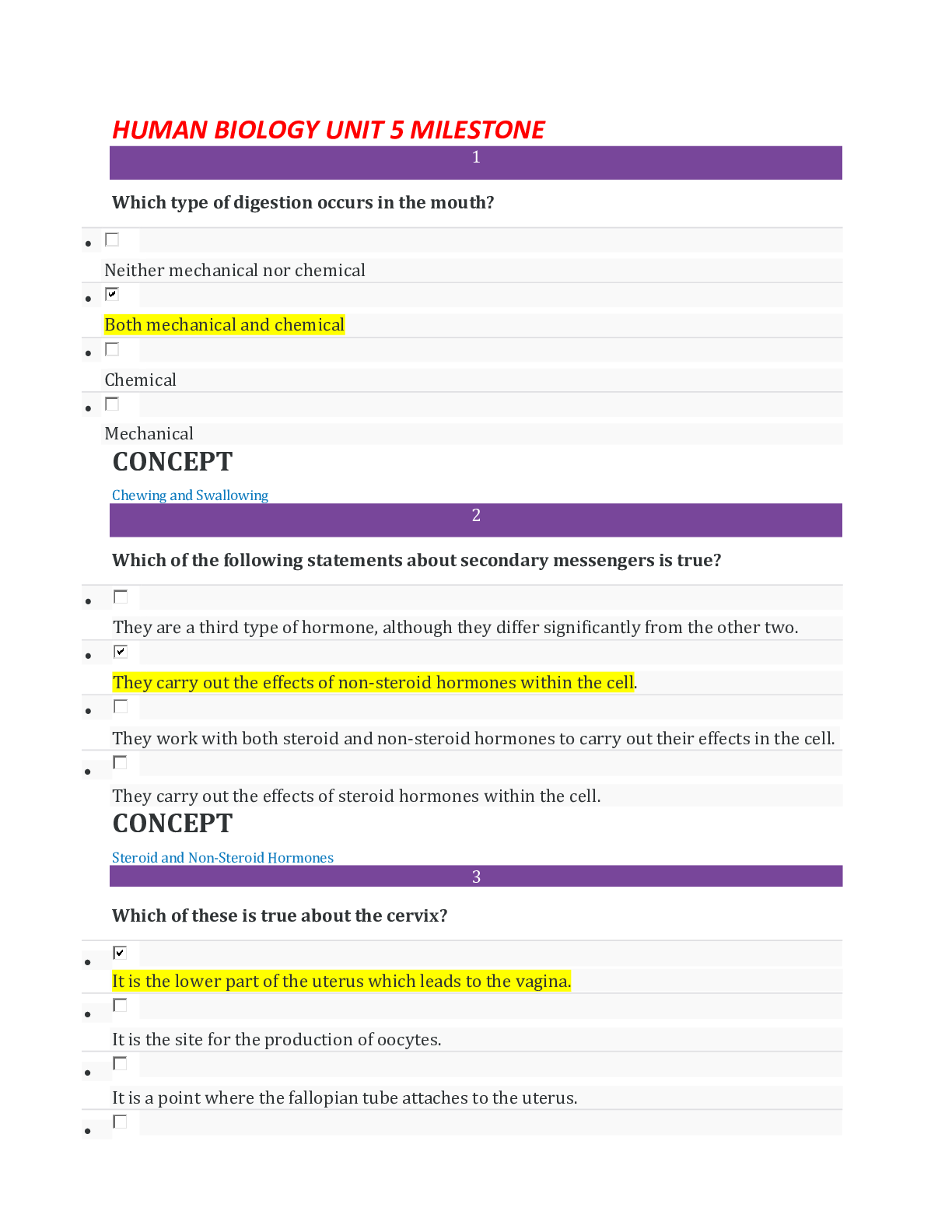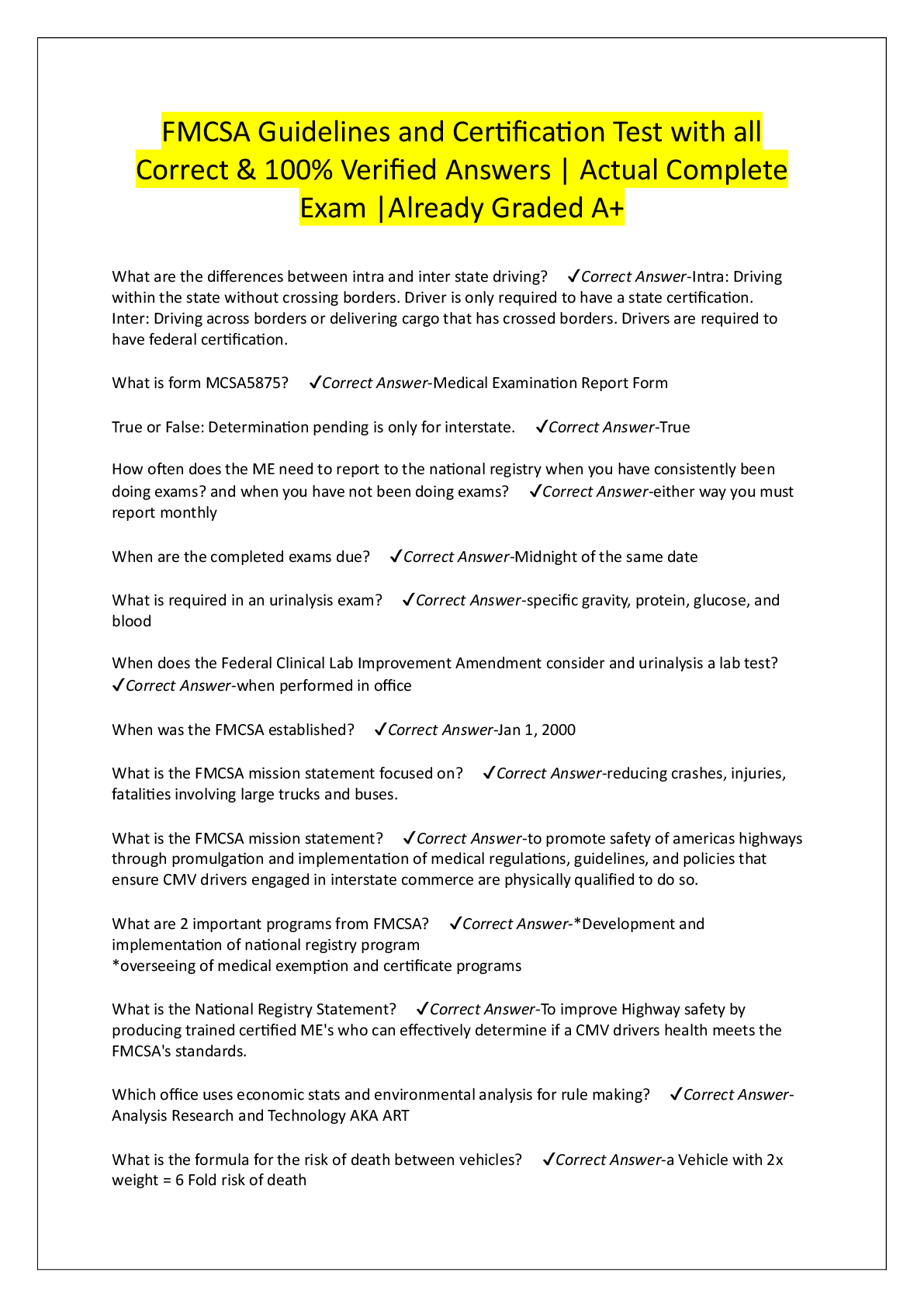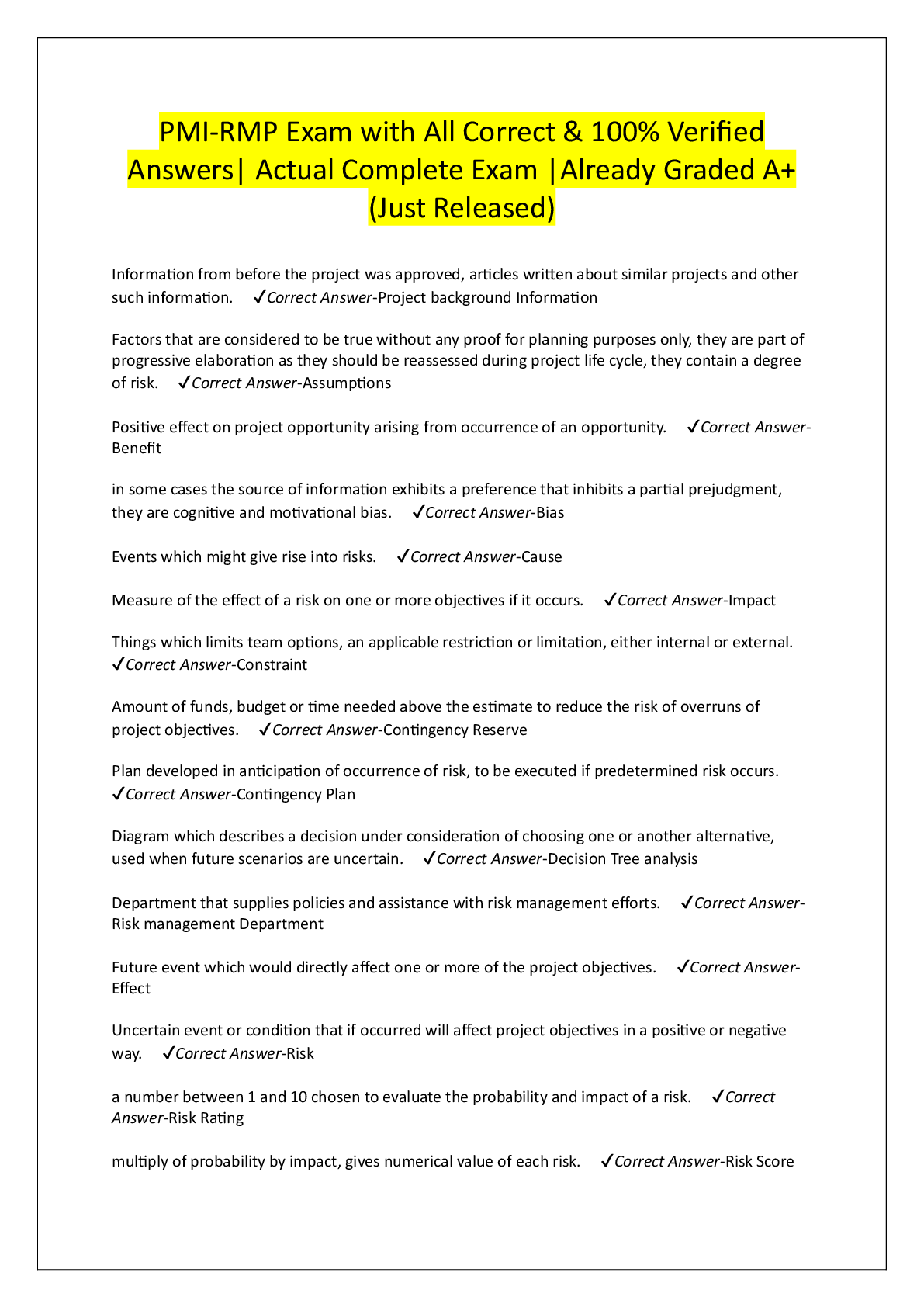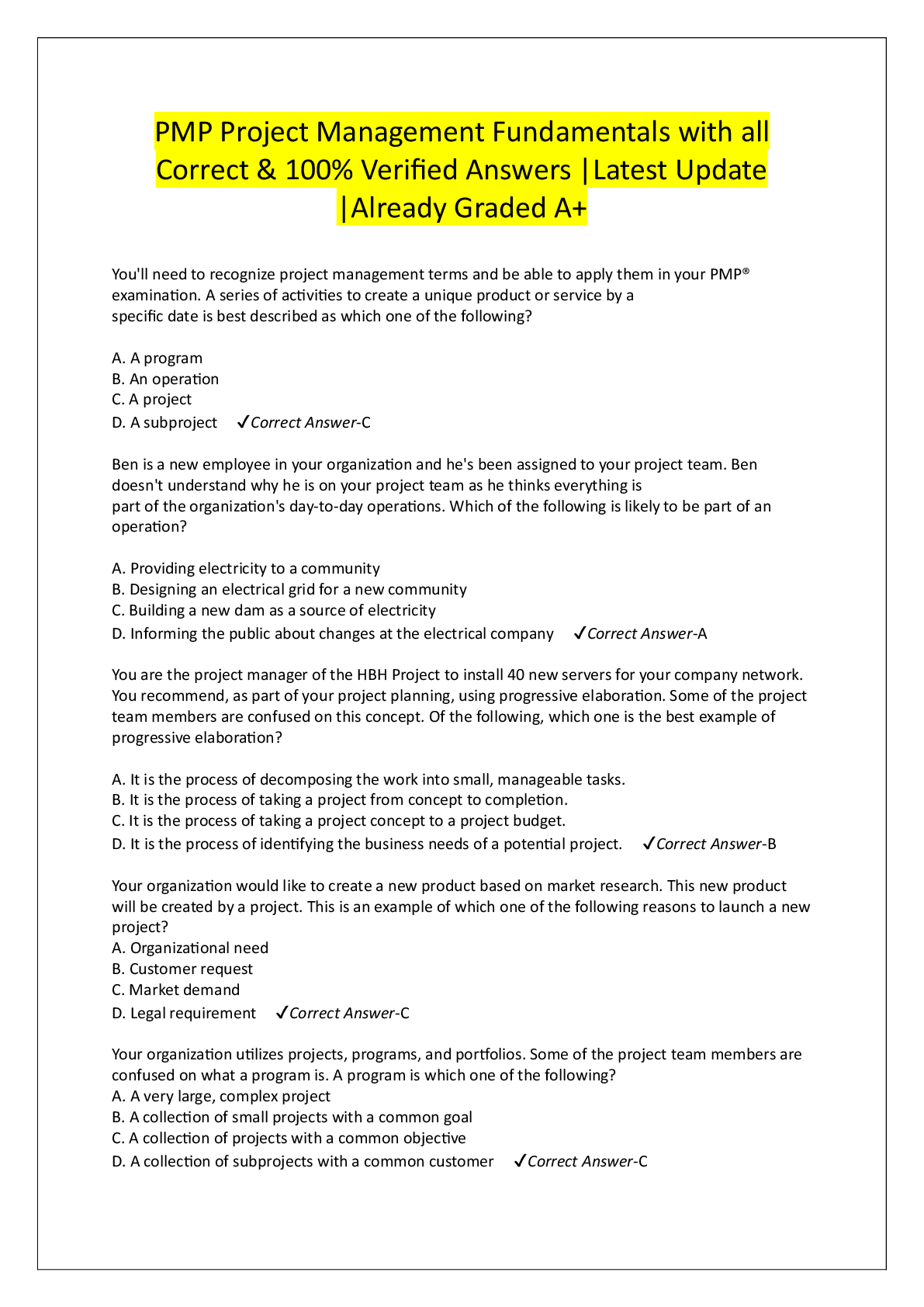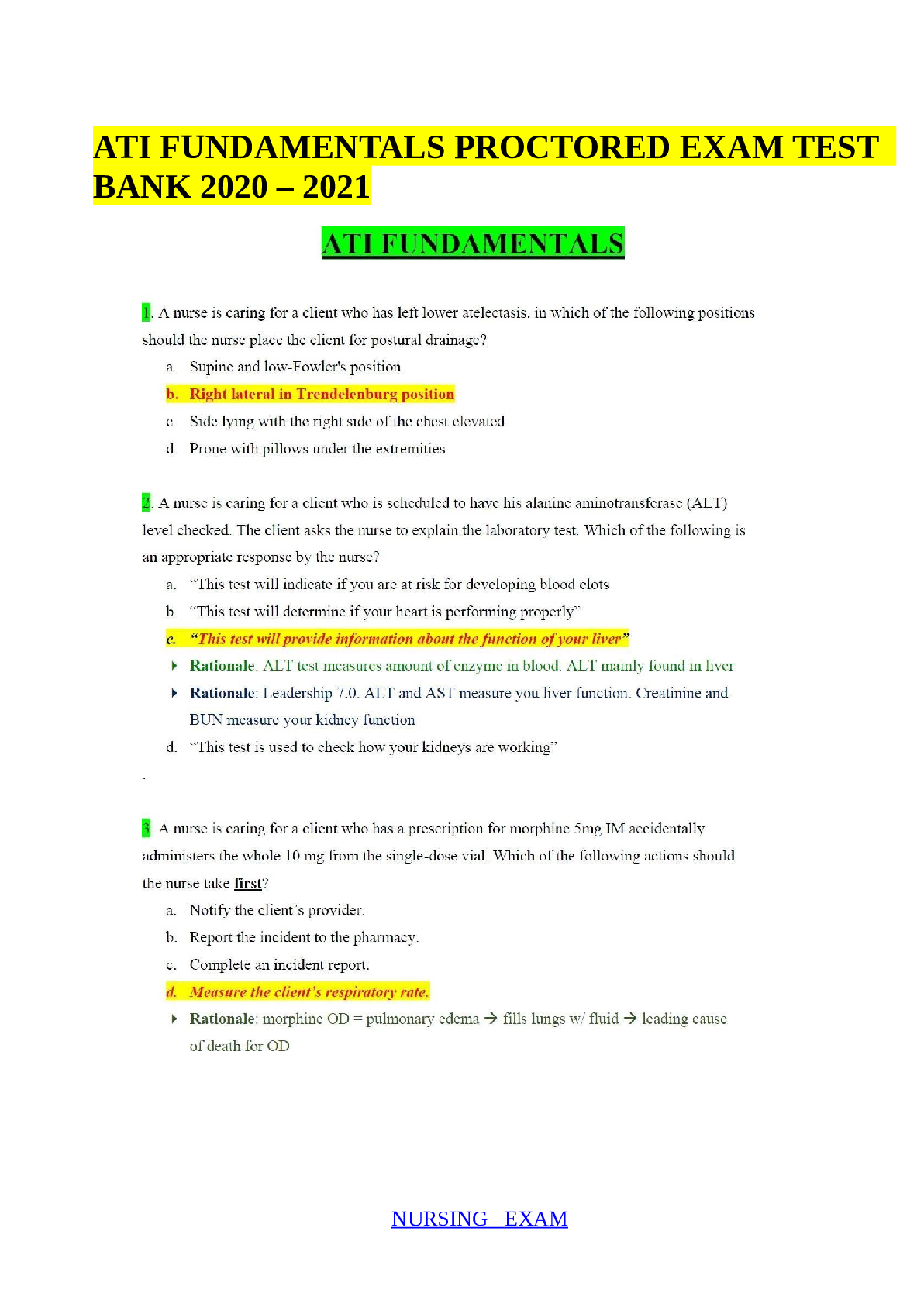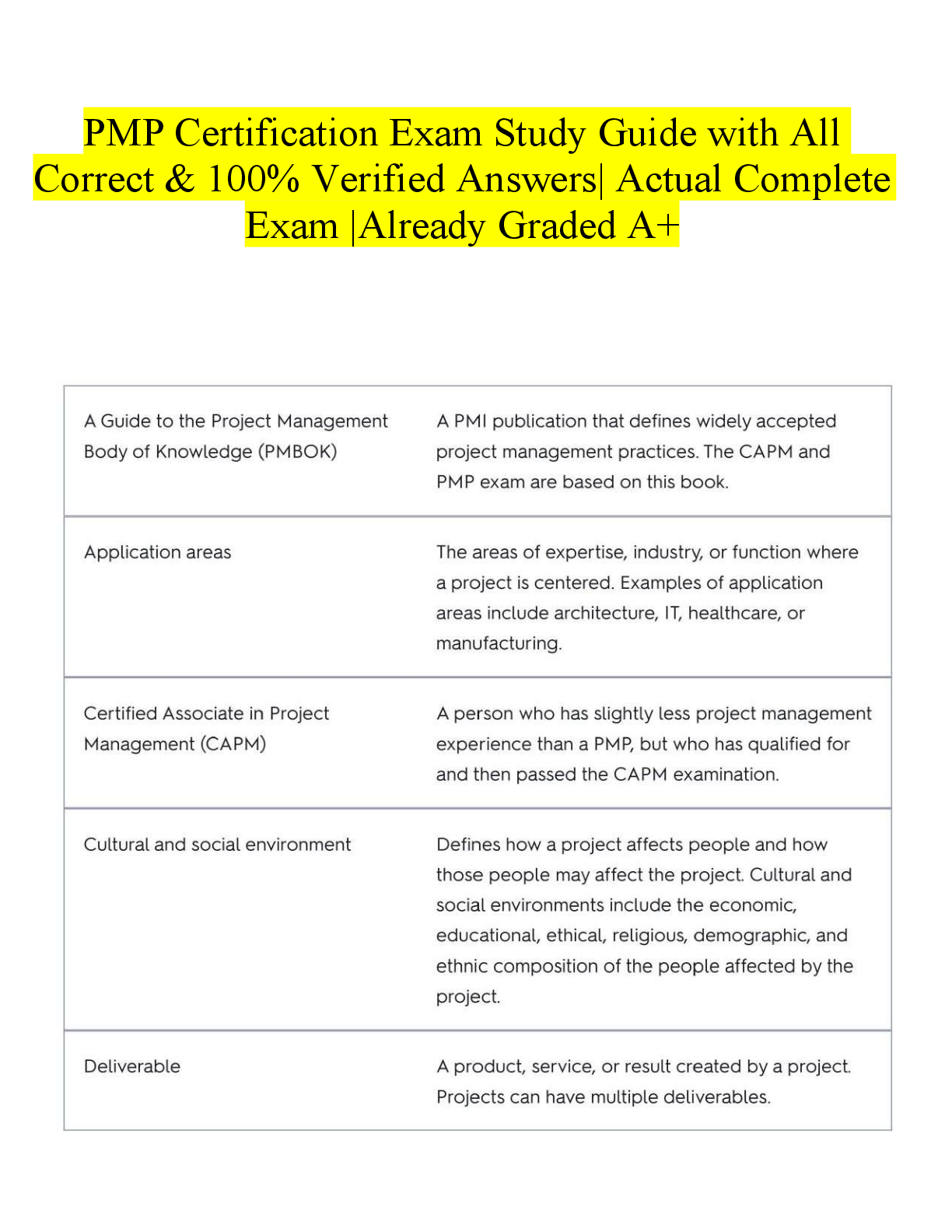Health Care > EXAM > NFPA 10 Portable Fire Extinguisher Exam 114 Questions with Verified Answers,100% CORRECT (All)
NFPA 10 Portable Fire Extinguisher Exam 114 Questions with Verified Answers,100% CORRECT
Document Content and Description Below
NFPA 10 Portable Fire Extinguisher Exam 114 Questions with Verified Answers Shall - CORRECT ANSWER Indicates a mandatory requirement. Should - CORRECT ANSWER Indicates a recommendation or that ... which is advised but not required. High Pressure Cylinder - CORRECT ANSWER Pressure hiigher than 500 psi Low Pressure Cylinder - CORRECT ANSWER Lower than 500 psi Dry Powder extinguishes Class D combustible metals fires by ________,________< or _________ - CORRECT ANSWER Crusting Smothering, heat transferring A quick check - CORRECT ANSWER Inspection A thorough examination - CORRECT ANSWER Maintenence Flammable liquids of Appreciable depth are those with a depth greater than - CORRECT ANSWER 1/4 inch Pressure testing of extinguisher against unwanted rapture - CORRECT ANSWER Hydrostatic Testing Loaded Stream Charge - CORRECT ANSWER A water based extinguishing agent that uses an alkali metal salt as a freezing point depressant. What does a Loaded stream charge use as a freezing point depressant? - CORRECT ANSWER alaki metal salt Extinguisher service pressure - CORRECT ANSWER The normal operating pressure indicated on the nameplate or cylinder of a fire extinguisher Factory test pressure - CORRECT ANSWER The pressure shown on the nameplate at which a shell was tested at time of manufacture. Pressurized flammable liquid fires result from liquids that are _______, ______, or ________ - CORRECT ANSWER Forced pumped or sprayed Servicing - CORRECT ANSWER performing maintenance, recharging, or hydrostatic testing on a fire extinguisher What does a wetting agent do when added to water? - CORRECT ANSWER reduces the surface tension and increases its ability to penetrate and spread Extinguisher where the expelling gas is in a separate container from agent storage container - CORRECT ANSWER Cartridge/Cylinder operated Water mist extinguishers contain - CORRECT ANSWER distilled or deionized water Class A fires are - CORRECT ANSWER Ordinary Combustibles Class B fires are - CORRECT ANSWER Flammable liquids, vapors, gas, oil, paint Class C fires involve - CORRECT ANSWER electrical equipment Class D fires involve: - CORRECT ANSWER Combustible metals Class K fires involve - CORRECT ANSWER Cooking media (Vegetable or animal oils and fats) Light Hazard Occupancies (LHO) - CORRECT ANSWER Class A combustibles and Class B flammables are low ordinary hazard occupancy - CORRECT ANSWER Class A combustibles and Class B flammables are moderate extra hazard occupancy - CORRECT ANSWER Class A combustable and class B flammables are high or expected Extinguishers shall be provided for the protection of both the - CORRECT ANSWER building structure and occupancy hazards Polar solvents are found in - CORRECT ANSWER Water soluble flammable liquid fires AFFF and FFFP should not be used on which type of fire - CORRECT ANSWER Water soluble flammable liquid What type of extinguisher should be used in areas containing oxidizers - CORRECT ANSWER water type Extinguishers shall be located - CORRECT ANSWER along normal paths of travel including exits from areas Labels that shall not be placed on the front of the extinguisher - CORRECT ANSWER HMIS 6 Year Hydrostatic Test Others Cabinets exposed to elevated temperatures shall be provided with - CORRECT ANSWER screened openings and drains Shall not be used in stainless steel extinguishers - CORRECT ANSWER calcium chloride Maximum travel distance for fire extinguisher - CORRECT ANSWER 75 ft How many water extinguishers with a 1-A rating fulfill one 2-A rated extinguisher requirements? - CORRECT ANSWER 2 How many 2.5 gallon water type extinguishers fulfill the requirements of one 4-A rated extinguisher - CORRECT ANSWER 2 Class D distance should not exceed - CORRECT ANSWER 75 Ft Class K distance should not exceed - CORRECT ANSWER 30 ft Tags or labels that indicate maintenance was performed shall identify - CORRECT ANSWER Month and Year Person performing work Agency performing work Six Year examination label size - CORRECT ANSWER 2 x 3.5 Six year examination labels should identify - CORRECT ANSWER Month and year Name of person Name of agency Conductivity tests are done for what type extinguisher - CORRECT ANSWER Carbon dioxide Conductivity testing label size - CORRECT ANSWER 1/2 x 3 Discharge hoses on wheeled type extinguishers shall be uncoiled and examined for damage at what interval - CORRECT ANSWER annually Electronic monitoring devices/system should be tested and maintained at what interval - CORRECT ANSWER annually Pressure Regulators on wheeled extinguishers shall be tested how often - CORRECT ANSWER annually Pressure regulators on wheeled type extinguishers are tested annually for - CORRECT ANSWER outlet static pressure and flow rate What should be performed after recharging stored pressure or self expelling extinguishers? - CORRECT ANSWER Leak test The premixed agent in AFFF and FFFFP extinguishers shall be replaced at what interval - CORRECT ANSWER every 3 years Multipurpose dry chemicals shall not be mixed with - CORRECT ANSWER Alakine based dry chemicals The vapor phase pf carbon dioxide shall not be less than what percent carbon dioxide - CORRECT ANSWER 99.5 The agents in these two extinguishers can not be reused during hydrostatic testing - CORRECT ANSWER wet chemical and water mist What shall be used to pressurize fire extinguishers? - CORRECT ANSWER A regulated source of pressure set no higher than 25psi above operating/service pressure Gauges used to set the regulated source of pressure shall be calibrated - CORRECT ANSWER annually Type of extinguisher that is not required to have a verification of service collar - CORRECT ANSWER Cartridge and cylinder operated What should be used as the test medium in hydrostatic testing - CORRECT ANSWER Water or other compatible non compressible fluids Test pressure gauges shall be accurate____ % or better of the full range of the gauge - CORRECT ANSWER +/-.5 Test pressure gauges shall be capable of being read to within _____% of the test pressure - CORRECT ANSWER 1 Test pressure gauges shall be capable of indicating ____% to ____% of the test pressure - CORRECT ANSWER 90 to 110 Pressure gauges used on test equipment shall be calibrated - CORRECT ANSWER semiannually Master gauges or dead weight testers shall be calibrated - CORRECT ANSWER annnually The temperature used for drying in hydrostatic testing shall not exceed _______ inside the shell - CORRECT ANSWER 150F Hydrostatic test pumps, hand or power operated, shall be capable off producing no less than ____ % of the test pressure - CORRECT ANSWER 150 The pressure in a hydrostatic test of a cylinder shall be maintained for how long - CORRECT ANSWER minimum 30 seconds` If heated air is used to dry cylinders in low pressure cylinders, the temperature inside the shell shall not exceed - CORRECT ANSWER 150F Test pressures done on hose assemblies shall be maintained for how long? - CORRECT ANSWER 1 minute Carbon dioxide extinguishers that have cylinder specification ICC3 shall be tested at what psi - CORRECT ANSWER 3000 High pressure cylinders shall be tested at what psi - CORRECT ANSWER 5/3 service pressure stamped in extinguisher Carbon dioxide hose assemblies hydrostat test pressure - CORRECT ANSWER 1250 Dry chemical/powder, water, foam, and halogenated agent hose assemblies hydrostatic test pressure - CORRECT ANSWER 300 psi or service pressure, whichever is higher Low pressure accessory hose on wheeled extinguisher hydrostatic test pressure - CORRECT ANSWER 300psi High Pressure accessory hose on wheeled extinguisher hydrostatic test pressure - CORRECT ANSWER 3000psi Hydrostat test low pressure cylinder label size - CORRECT ANSWER 2x3.5` Liquid carbon dioxide forms _______ when released directly into atmosphere - CORRECT ANSWER dry ice "snow" Carbon dioxide gas is how many times heavier than air - CORRECT ANSWER 1.5 How does carbon dioxide extinguish fire? - CORRECT ANSWER By reducing concentrations of oxygen, the vapor phase of fuel, or both in the air until combustion stops Class I commodities - CORRECT ANSWER generally non-combustible and stored on wood pallets in ordinary packaging. can be packaged in corrugated cardboard or stretch wrapped as a unit load Class II commodities - CORRECT ANSWER non-combustible commodities but packaged in wooden crates or mulit-layered cardboard cartons Three dimensional fires involves - CORRECT ANSWER Class B materials in motion Three dimensional fires involve class B materials that are in motion such as - CORRECT ANSWER pouring, running, or dripping flammable liquids and include vertical as well as 1 or more horizontal surfacesC Class K placard size - CORRECT ANSWER 7 5/8 x 11in Dry chemical fire extinguishers containing ammonium compounds should not be used on - CORRECT ANSWER oxidizers containing chlorine Explosive compound caused by the reaction between oxidizer and ammonium salts - CORRECT ANSWER Nitrogen Trichloride Acceptable means for identifying extinguisher locations - CORRECT ANSWER arrows, lights, signs, or coding wall or columns Venter cabinets constructed with tinted glass lower the maximum internal temp by how many degrees - CORRECT ANSWER 10F to 15F should not be used in stainless steel extinguishers - CORRECT ANSWER calcium chloride solutions Labels should be printed in _____ with a _______ background color - CORRECT ANSWER black light blue Hydrostat test label print and background color - CORRECT ANSWER black with silver background Markings should be easily legible from what distance - CORRECT ANSWER 3 ft Markings applied to wall panels should be easily legible from what distance - CORRECT ANSWER 15ft Advantage of Carbon dioxide extinguisher - CORRECT ANSWER it leaves no residue Carbon dioxide extinguishers are listed for used on what class fires - CORRECT ANSWER B and C Range of Carbon dioxide extinguisher - CORRECT ANSWER 3-8ft - CORRECT ANSWER ANSI - CORRECT ANSWER American National Standards Institute Carbon Dioxide - CORRECT ANSWER A colorless, odorless, electrically non conductive inert gas that is a suitable medium for extinguishing Class B and Class C fires 2 types of chemical - CORRECT ANSWER Wet and Dry Wet Chemical - CORRECT ANSWER Normally an aqueous solution of organic or inorganic salts or a combination thereof that forms an extinguishing agent Dry Chemical - CORRECT ANSWER A powder composed of very small particles, usually sodium bicarbonate-,potassium bicarbonate-, or ammonium phosphate based with added particulate material supplemented by special treatment to provide resistance to packing, resistance to moisture absorption (caking), and the proper flow capabilities High Pressure Cylinder - CORRECT ANSWER Cylinders containing nitrogen, compressed air, carbon dioxide, or other gases at a pressure higher than 500 psi at 70 degrees Dry Powder - CORRECT ANSWER Solid materials in powder or granular form designed to extinguish Class D combustible metal fires by crusting, smothering, or heat-transferring means Extinguisher Inspection - CORRECT ANSWER A quick check that a fire extinguisher is in its designated place, that it has not be actuated or tampered with, and that there is no obvious physical damage or condition to prevent its operation Film-forming foam agents - CORRECT ANSWER Aqueous film-forming foam (AFFF) and film forming fluoroprotein foam (FFFP) Appreciable depths - CORRECT ANSWER Depth greater than a quarter inch Halocarbons - CORRECT ANSWER Halocarbon agents include hydrochlorofluorocarbon (HCFC), hydrofluorocarbon (HFC), perfluorocarbon (PFC), and fluoroiodocarbon (FIC) types of agents Halons - CORRECT ANSWER Halons include bromochlorodifluoromethane ( Halon 1211), bromotrifluoroethane (Halon 1301), and mixtures of Halon 1211 and Halon 1301 ( Halon 1211/1301) Mild Steel Shell - CORRECT ANSWER All steel shells other than stainless steel and steel shells used for high pressure cylinders Servicing - CORRECT ANSWER Performing maintenance, recharging, or hydrostatic testing on a fire extinguisher Travel Distance - CORRECT ANSWER The actual walking distance from any point to the nearest fire extinguisher fulfilling hazard requirements Self-expelling fire extinguisher - CORRECT ANSWER A fire extinguisher in which the agents have sufficient vapor pressure at normal operating temperatures to expel themselves Obsolete fire extinguishers - CORRECT ANSWER Soda acid Chemical foam Vaporizing liquid Cartridge operated water Cartridge operated loaded stream Copper or brass shell joined by soft solder or rivets Solid charge Pressurized water fire extinguishers manufactured prior to 1971 Any extinguisher that needs to be inverted to operate Any stored pressure extinguisher manufactured prior to 1955 Any extinguishers with 4b, 6b, 8b, 12b, and 16b fire ratings Stored pressure water extinguishers with fiberglass shells (pre-1976) Classifying Occupancy Hazard - CORRECT ANSWER Rooms or areas shall be classified as being light (low) hazard, ordinary (moderate) hazard, or extra (high) hazard Light (low) hazard - CORRECT ANSWER locations where the quantity and combustibility of Class A combustibles and Class B flammables are low and fires with relatively low rates of heat release are expected. These occupancies of fire hazards having normally [Show More]
Last updated: 2 years ago
Preview 1 out of 11 pages

Buy this document to get the full access instantly
Instant Download Access after purchase
Buy NowInstant download
We Accept:

Also available in bundle (1)
Click Below to Access Bundle(s)

NFPA 10 fire extinguishers Exam ( 34 Sets) Questions with Verified Answers,100% CORRECT
NFPA 10 Portable Fire Extinguishers 71 Questions with Verified Answers,NFPA 10 Exam 34 Questions with Verified Answers,NFPA 10 Standard for Portable Fire Extinguishers 60 Questions with Verified Answe...
By securegrades 2 years ago
$35
34
Reviews( 0 )
$9.00
Can't find what you want? Try our AI powered Search
Document information
Connected school, study & course
About the document
Uploaded On
Dec 09, 2023
Number of pages
11
Written in
All
Additional information
This document has been written for:
Uploaded
Dec 09, 2023
Downloads
0
Views
102



